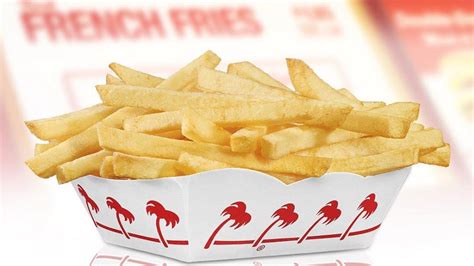
Craving crispy fries at In-N-Out Burger? A simple ordering hack—requesting your fries “well-done”—promises to eliminate the chain’s notorious soggy spuds, delivering a consistently crunchy experience according to a former employee.
In-N-Out Burger, a West Coast fast-food staple, is beloved for its simple menu and fresh ingredients. However, one menu item has consistently drawn criticism: the fries. Many customers find In-N-Out’s fries to be disappointingly soggy, lacking the crispiness one typically expects from fried potatoes. This issue has led to numerous online discussions and attempts by fans to find solutions. Now, a purported insider tip is circulating, offering a straightforward solution: ordering the fries “well-done.”
According to a former In-N-Out employee, requesting fries “well-done” ensures they are cooked longer, resulting in a crispier texture. This seemingly simple adjustment addresses the common complaint about the fries’ lack of crunch. The employee revealed this tip, suggesting it’s a widely known trick within the company to satisfy customers seeking a more robust fry experience.
The problem of soggy fries at In-N-Out isn’t new. It stems from the company’s commitment to using fresh, never-frozen potatoes. While this dedication to quality ingredients is commendable, it also presents a challenge in achieving consistent crispiness. Fresh potatoes have a higher water content compared to frozen fries, which have already undergone a partial dehydration process. This higher moisture level can lead to a less-than-ideal fry texture if not properly managed during the cooking process.
In-N-Out’s fries are prepared in a two-step process. First, the potatoes are washed, peeled, and cut in-house. Then, they are fried in 100% sunflower oil. The oil temperature and frying time are crucial factors in determining the final texture of the fries. When fries are not cooked long enough or at a high enough temperature, the excess moisture remains, resulting in a soggy product.
Ordering fries “well-done” essentially instructs the cooks to extend the frying time, allowing more moisture to evaporate and creating a crispier exterior. This method is not unique to In-N-Out; it’s a common practice in many restaurants to accommodate customer preferences for different levels of doneness.
The “well-done” fry hack has gained traction on social media platforms, with many users confirming its effectiveness. Customers who have tried this method report a noticeable improvement in the fries’ texture, making them more enjoyable. The widespread sharing of this tip highlights the collective desire for a solution to the soggy fry problem and the power of online communities in disseminating insider information.
However, it’s important to note that ordering fries “well-done” may also have some drawbacks. Overcooking fries can result in a harder, drier texture, potentially sacrificing some of the potato’s natural flavor. Some customers may find well-done fries to be too crunchy or even slightly burnt. Therefore, it’s essential to consider personal preferences when deciding whether to try this hack.
Another popular method to combat soggy fries at In-N-Out is to order them “extra well-done.” This takes the “well-done” concept a step further, resulting in even crispier fries. However, ordering “extra well-done” carries a higher risk of overcooking, so it’s crucial to communicate your preferences clearly to the In-N-Out employee taking your order.
Some customers also suggest ordering fries “lightly salted” to further enhance their crispiness. Excess salt can draw moisture out of the fries, contributing to a soggy texture. By requesting less salt, you may help the fries retain their crispness for a longer period.
Beyond these specific ordering hacks, the best way to ensure your In-N-Out fries are as fresh and crispy as possible is to eat them immediately after receiving your order. Fries, in general, tend to lose their crispness over time as they cool down and absorb moisture. Therefore, enjoying them while they’re hot and fresh is crucial.
In-N-Out Burger has not officially commented on the “well-done” fry hack. However, the company is known for its commitment to customer satisfaction and its willingness to accommodate special requests. In-N-Out’s menu is intentionally simple, allowing employees to focus on quality and customization. This flexibility extends to the fries, where customers can request various modifications to suit their preferences.
The popularity of In-N-Out Burger is a testament to its consistent quality and customer service. Founded in 1948 by Harry and Esther Snyder, the company has remained family-owned and operated for over 75 years. In-N-Out is known for its fresh ingredients, made-to-order burgers, and friendly employees. The company’s commitment to quality and customer satisfaction has earned it a loyal following, particularly in California and other Western states.
In-N-Out’s menu features a limited selection of burgers, fries, shakes, and drinks. The simplicity of the menu allows the company to focus on using high-quality ingredients and providing excellent service. In-N-Out’s burgers are made with fresh, never-frozen beef patties and topped with fresh produce. The buns are baked daily, and the shakes are made with real ice cream.
The company’s commitment to quality extends to its employees. In-N-Out is known for paying its employees well and providing excellent benefits. This has resulted in a low turnover rate and a team of dedicated employees who are passionate about providing excellent customer service.
In conclusion, the “well-done” fry hack offers a potential solution to the common complaint about soggy fries at In-N-Out Burger. By requesting fries cooked longer, customers can achieve a crispier texture that enhances their overall dining experience. While individual results may vary depending on personal preferences and the specific location, this tip is worth trying for those seeking a more satisfying fry experience. However, it’s vital to be mindful that “well-done” may lead to a harder, drier texture that not everyone will appreciate. Experimentation and clear communication with In-N-Out employees are key to finding the perfect level of crispiness. The persistent interest in perfecting the In-N-Out fry experience demonstrates the chain’s enduring appeal and the strong connection customers feel with its brand. This pursuit of fry perfection also underscores the importance of small, customizable details in the fast-food industry, where customer satisfaction often hinges on the ability to personalize one’s order. The “well-done” hack is more than just a food tip; it’s a symbol of the ongoing conversation between In-N-Out and its loyal customers, a dialogue that helps shape the dining experience and maintain the chain’s reputation for quality and responsiveness.
Ultimately, whether you opt for “well-done,” “extra well-done,” “lightly salted,” or simply fresh and hot, the key is to enjoy your In-N-Out fries according to your personal preference. The enduring popularity of In-N-Out lies in its ability to cater to individual tastes while maintaining a commitment to quality and freshness.
FAQ: In-N-Out Fries and the “Well-Done” Hack
1. What is the “well-done” fry hack for In-N-Out fries?
The “well-done” fry hack is a customer tip that suggests ordering your fries “well-done” at In-N-Out Burger. This means requesting that the fries be cooked for a longer period, resulting in a crispier texture. The hack aims to address the common complaint of In-N-Out fries being too soggy.
2. Why are In-N-Out fries often considered soggy?
In-N-Out uses fresh, never-frozen potatoes, which have a higher water content compared to frozen fries. This higher moisture level can lead to a less crispy texture if the fries are not cooked adequately to remove the excess moisture. The two-step frying process, while intended to produce quality fries, can sometimes result in sogginess if not executed precisely.
3. How effective is the “well-done” fry hack?
Many customers who have tried the “well-done” fry hack report a noticeable improvement in the fries’ texture. They find that the fries are crispier and less soggy compared to the standard preparation. However, the effectiveness can vary depending on the specific location, the cooks, and individual preferences.
4. Are there any downsides to ordering fries “well-done”?
Yes, overcooking fries can result in a harder, drier texture, potentially sacrificing some of the potato’s natural flavor. Some customers may find “well-done” fries to be too crunchy or even slightly burnt. It’s essential to consider personal preferences when deciding whether to try this hack. Additionally, consistency can vary between different In-N-Out locations.
5. What are some other tips for getting crispier fries at In-N-Out?
- Order “extra well-done”: This takes the “well-done” concept a step further, resulting in even crispier fries, but with a higher risk of overcooking.
- Order “lightly salted”: Excess salt can draw moisture out of the fries, contributing to a soggy texture.
- Eat them immediately: Fries, in general, tend to lose their crispness over time as they cool down and absorb moisture.
- Ask for them “in a tray”: This ensures that the fries don’t steam in a closed bag, which can lead to sogginess.
6. Does In-N-Out officially endorse the “well-done” fry hack?
In-N-Out Burger has not officially commented on the “well-done” fry hack. However, the company is known for its commitment to customer satisfaction and its willingness to accommodate special requests. The menu’s simplicity allows employees to focus on quality and customization, including fry modifications.
7. What type of oil does In-N-Out use to fry their fries?
In-N-Out fries are fried in 100% sunflower oil. This type of oil is known for its neutral flavor and high smoke point, making it suitable for frying.
8. Can I order my fries “raw” or “lightly fried” at In-N-Out?
While In-N-Out is generally accommodating, ordering fries “raw” is not a standard request and likely would not be fulfilled due to food safety concerns. Ordering them “lightly fried” might be possible, but it’s essential to communicate clearly with the employee taking your order to ensure they understand your request. Keep in mind that ordering fries significantly undercooked could lead to a less enjoyable and potentially unsafe eating experience.
9. How does In-N-Out prepare its fries?
In-N-Out’s fries are prepared in a two-step process. First, the potatoes are washed, peeled, and cut in-house. Then, they are fried in 100% sunflower oil. The oil temperature and frying time are crucial factors in determining the final texture of the fries.
10. What kind of potatoes does In-N-Out use?
In-N-Out uses fresh, whole potatoes that are cut in-house. The specific type of potato used is typically Russet potatoes, known for their high starch content, which is suitable for frying.
11. How does the freshness of the potatoes affect the fries?
Using fresh, never-frozen potatoes is a core part of In-N-Out’s commitment to quality. However, fresh potatoes have a higher water content compared to frozen fries. This higher moisture level can lead to a less crispy texture if not properly managed during the cooking process. Proper frying techniques are essential to evaporate the excess moisture and achieve the desired crispness.
12. What is the history of In-N-Out Burger?
In-N-Out Burger was founded in 1948 by Harry and Esther Snyder in Baldwin Park, California. It was one of the first drive-thru hamburger stands in California. The company has remained family-owned and operated since its inception and is known for its commitment to quality, customer service, and employee well-being.
13. How does In-N-Out ensure quality control?
In-N-Out maintains strict quality control measures throughout its operations, from sourcing fresh ingredients to preparing food in-house. They have a limited menu, which allows them to focus on the quality of each item. They also emphasize employee training and development to ensure consistent preparation and service standards. Regular inspections and audits are conducted to maintain these standards.
14. How does In-N-Out handle customer complaints about soggy fries?
While In-N-Out does not officially address the issue of soggy fries, their commitment to customer satisfaction suggests that they would likely address individual complaints on a case-by-case basis. Customers can express their concerns to the staff, and In-N-Out employees are often willing to remake orders or offer alternative solutions to ensure customer satisfaction.
15. What role does the altitude of the In-N-Out location play in the crispiness of the fries?
Altitude can affect the boiling point of water and the cooking time of food. At higher altitudes, water boils at a lower temperature, which can impact the frying process. Fries cooked at higher altitudes may require adjustments to frying time and temperature to achieve the desired crispiness. This is a factor that In-N-Out may need to consider in locations at higher elevations.
16. Are In-N-Out fries vegan or vegetarian?
In-N-Out fries are generally considered vegetarian, as they are fried in 100% sunflower oil. However, the vegan status is less certain, as there is a risk of cross-contamination with other products cooked in the same oil. Vegans may want to inquire about the specific practices at their local In-N-Out to ensure the fries meet their dietary requirements.
17. How does the temperature of the oil affect the fries?
The oil temperature is crucial for achieving crispy fries. If the oil is not hot enough, the fries will absorb more oil and become soggy. If the oil is too hot, the fries may burn on the outside while remaining undercooked on the inside. Maintaining the correct oil temperature is essential for proper frying.
18. Does In-N-Out offer any dipping sauces for their fries?
In-N-Out does not offer a wide variety of dipping sauces. Their standard condiment options include ketchup, mustard, and spread (the same sauce used on their burgers). Customers can also request chopped chilies to add some heat to their fries. Some customers create their own dipping sauces by mixing ketchup and spread.
19. How does ordering fries “animal style” affect their texture?
Ordering fries “animal style” means they are topped with melted cheese, grilled onions, and spread. This addition can make the fries soggier, as the toppings add moisture. To mitigate this, some customers order their fries “well-done” or “extra well-done” before adding the “animal style” toppings.
20. What is the nutritional information for In-N-Out fries?
A regular order of In-N-Out fries contains approximately 395 calories, 19 grams of fat, 54 grams of carbohydrates, and 7 grams of protein. Nutritional information can vary slightly depending on preparation methods and portion sizes. Customers can find detailed nutritional information on In-N-Out’s website or by asking an employee.









